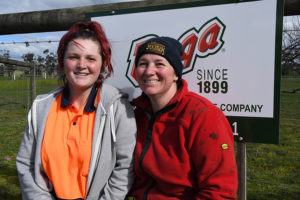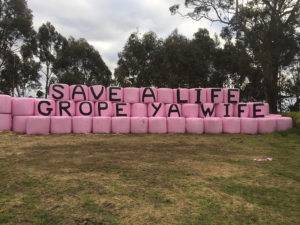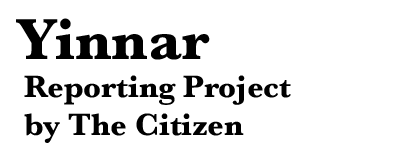
All in this together: working the farm is a family affair
Life on a dairy farm is dictated by the needs of the cows, and Tammy Pettigrew-Brister wouldn’t have it any other way. Simone Williams reports. Video and photos by Minka Curr.
It’s 5am and Tammy Pettigrew-Brister is already well into her working day. The sun is yet to rise, but she is striding around the dairy in gumboots, and swathed in orange high-vis.
It’s peak calving season, and there can be up to 20 new arrivals a day on her Gippsland farm, nestled in the Strzelecki Ranges. The typical day involves milking about 150 cows, before tending to and feeding the newborn calves – her priority at this time of the year. “These are our future,” she says, gesturing to a pen of baying calves. “In two years, they’ll be our herd. We have to look after them now.”
The routine of twice-a-day milking is just what it is in her game. She’s never known anything different. “We all had to do it. When we were in Year 11 and Year 12. We’d come home, and say that you had homework, you have to milk first.”
Tammy’s family is steeped in dairy farming, these ranges and the township of Yinnar. Their lineage goes back to 1874 – Tammy points out a quaint homestead, easily spotted from the home dairy, as being the property that has been in the family for more than a century. At age 41, she makes up the middle of three generations of family actively involved in the farm. There’s linchpin Annette, Tammy’s mother, who lives down the road, and bringing up the rear is Tammy’s 18-year-old daughter Carly.
It’s quite simple, according to Tammy. “We just work for mum.” The “we” refers to Tammy and her brother Scott, who lives on the property itself. Tammy, her husband, her son Owen and daughter Carly live a kilometre away, in a cheerful house overlooking the 400 hectares of farmland.
Both of Tammy’s children are involved in the day-to-day mechanics of operating a dairy farm, with her daughter Carly, a tenacious young woman with a passion for agriculture and the science behind it, now becoming a driving force for the future of the family business.
Having graduated from high school last year, Carly is now facing a whole new set of grown-up challenges, from impending drought and rising bills, to battling entrenched sexism in the dairy industry. She’s not shy from tackling any of it.
“I get really offended when people say that it’s a man’s job, because I am a third-generation female farmer, and we are just as capable as men to do the same thing.”
During the morning, mother and daughter work together, giving hay and antibiotic milk to the newborns, paying special attention to the ones that are struggling. Tammy stretches out the gnarled and knuckled hooves of one calf, and Carly feeds another limp, exhausted calf by hand. There’s real connection here, between human and animal, which can be hard when times turn tough.
One cow has been given an epidural by the town vet. She is bloated with the weight of a calf that will never take a breath, and the vet reaches in and rearranges the baby within her, so that the breech birth can take place. The inevitable occurs, the dead calf sliding slick and still from its mother. The cow sways over to its calf, lying on the floor of the dairy, and nudges the newborn, before trotting away. One of the hardest, emotional strains of the job is watching the animals suffer. “This is the second time that we have had the vet out this season,” says Tammy.
Carly seems to take it all in her stride. “I am working all the time, so I do feel older,” she says. “It sucks that I can’t go out clubbing all the time, but I’m working and saving for a house.” By 16, she had already bought her first car with the milking money she’d earned.
But even if she did feel the urge for some time out, Yinnar is a small town, and opportunities are scarce for socialising with other people her age. “I have only stayed in contact with two people from school, out of a graduating class of 250,” Carly says. “It was a little bit isolating.”
The isolation Carly is experiencing is not confined to her social life – such as it is. There aren’t many young women in the dairy industry, and she’s been struggling a bit to find acceptance. However, lately she’s been enrolled in a certificate course in artificial insemination, which has given her a chance to connect with several other female farmers.
“I met some girls my own age, and we are all learning the same stuff, when previously I have really only worked with guys in the dairy industry,” she says. “People think it’s just a man’s job and not for women, so it was really interesting and nice to meet girls.”
She credits her mother with being a role model throughout her childhood. “Working with her, she does just a good job as the boys,” Carly says. “It is just something that I look up to.”

Carly and Tammy
Tammy also faces judgment from her friends for “choosing” the agricultural lifestyle.
“Yeah, it’s ‘just’ farming, or you’re ‘just on a farm.’ My friends will ask, ‘where are you working now … oh so you’re just on the farm?’ – it’s bloody hard! But really, nobody experiences it, they just don’t understand what you do.”
Despite the deceptive lush green of the Gippsland hills, the drought which is hitting hard in other parts of the country is a reality here too.
This year, due to a late autumn, 50 animals had to go to market because the family simply wouldn’t have enough hay to feed them.
Though the Gippsland climate has delivered enough rain to maintain green growth in the paddocks, it’s not growing at the rate it should and the creek is only half full. The women are apprehensive about the forecast horror summer.
“The drought has a big impact on the dairy industry, because the market is flooded with stock,” Tammy says.
“Not only does it make our grain prices dearer, but we are selling our stock at reduced prices as well. It is affecting the whole agricultural industry as well, not just the isolated farmers.”
Other unexpected curveballs have also taken their toll on the business. A cow managed to switch their water meter from creek water to the town supply – “which has given us a water bill in the tens of thousands”.
For Tammy, one way to find some peace amid the chaos is to open up channels of artistic expression, albeit still with an agricultural bent. Which explains why one of her sheds is littered with the tattered remains of huge, plastic zoo animals. They were created by Tammy using farm materials, including decorated silage bales, and displayed for the amusement of passers by in the paddocks – until they were destroyed by some of her bulls.
When Tammy’s mother, Annette, was diagnosed with cancer, brother Scott started to buy pink-wrapped silage bales to support the Jane McGrath Foundation. Tammy created messages to support her mother and the cause, and displayed them around the farm. Her efforts were rewarded with an all-expenses-paid trip to Sydney for the Jane McGrath pink test after constructing a quote that was popular with the locals: “SAVE A LIFE – GROPE YA WIFE.”
 Silage art. (Photo courtesy of Tammy)
Silage art. (Photo courtesy of Tammy)
Annette has since recovered, but Tammy continues to enlist silage art as a creative outlet, making various, detailed scenes which are enjoyed by the locals, and occasionally regional media. Her latest endeavour, a collection of zoo animals, spanning from a lofty giraffe to a low, snapping croc, were ruined, but she grins as she remembers anonymous members of the public dropping Christmas presents into her letterbox, as a thanks for the joy that her silage art brought them.
“When I am doing the bale art – people will stop and talk to me,” she says, “and I don’t know them.”
By 2pm, Tammy and Carly have already had a nine-hour working day, and it’s not over yet. They set about preparing for their final milk, calling up the girls from the paddock.
“The lifestyle involves long days, and it’s tiring,” Tammy says. “But as far as family goes …”
Carly doesn’t hesitate to finish her sentence. “It’s worth it.”
Gallery not found.
